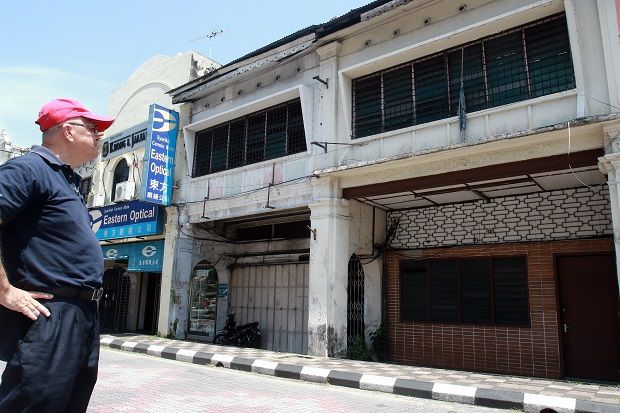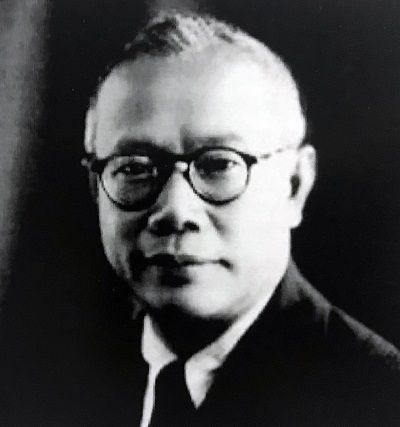The Foong Seong building was built by a rich miner. The upper floors are now unoccupied.
SEVERAL heritage buildings located in Ipoh should be preserved, refurbished and turned into tourist destinations, a heritage advocate has said.
Non-governmental organisation (NGO) Ipoh City Watch president Professor Richard Ng said there were several iconic buildings, some unoccupied and some used as business premises, that were not being maintained properly.
The former Ipoh city councillor said it would be a good idea for the authorities to gazette such buildings to preserve their architectural and historical legacy.
He cited buildings such as the Foong Seong Building in Jalan Laxamana, the Ma Jie House and the old Ruby Cinema, both located in Jalan Sultan Abdul Jalil, and Dr Wu Lien Teh’s clinic in Jalan Sultan Idris Shah.
These buildings were constructed between 1908 and the early 1930s.
Prof Ng was the main researcher involved in developing the Ipoh’s Cantonese Heritage Trail (both at the old town and the new parts of the city), and his book titled Paloh: Founded by Hakka, Made Vibrant by the Cantonese that was launched by the Ipoh mayor last month.
His book highlights the contributions of the Chinese sub-ethnic Hakka migrants and how Ipoh was made vibrant by the Cantonese.
“If the buildings are gazetted, the council can work with Chinese associations as well as other private sector companies to turn it into tourism-related products such as museums, cafes and entertainment outlets, by ensuring that the building façades are maintained.
“It is important that the heritage buildings are maintained to ensure that heritage and historical information is not lost.“We don’t want to see such buildings torn down, like what happened to the former Sun Cinema in Jalan Sultan Idris Shah some 20 years ago. The land was converted into a carpark.
“If such old buildings are not maintained, we will then be seeing more carparks,” he said.
Prof Ng then touched on several heritage buildings which, he said, were in poor condition and in dire need of refurbishment.
Referring to Dr Wu Lien Teh’s clinic on the same road, Prof Ng said in his book that Dr Wu, who hailed from Penang, was a renowned physician who went to provide field assistance when China faced the Manchurian plague from 1910 and 1911.
He said Dr Wu, who invented the face mask, started the crematorium services at Sam Poh Tong temple and also initiated the anti-opium campaign in 1906 in Ipoh.
“His clinic, which is currently unoccupied, could be transformed into a museum,” Prof Ng suggested.
He said Dr Wu retired in 1957 and died in 1960.
Another iconic landmark is the three-storey Foong Seong building, which was built by a rich tin miner.
Prof Ng said it used to house a primary school during the day and hosted Chinese opera and theatre performances in the evenings on the top floor.
He said the second floor was used as living quarters, and the ground floor was occupied by shops.
“Currently, only the ground floors are rented by business operators. The upper floors are unoccupied,” he said, adding that the building looked dilapidated.
Another building that is currently unoccupied it the Ma Jie building.
According to Prof Ng, the ma jie (domestic helpers) had left their families in China, took a vow of celibacy and to remain single until their last breath in order to secure the job.
He said 25 ma jie bought the building with their savings, but when they all passed away with no beneficiaries to take possession, the place was left vacant.
“I have suggested to the Ipoh City Council to set up a museum, because some of the belongings of the ma jie are kept by some Chinese associations and can be put on display,” he added.
Ruby Cinema, one of several cinemas located in the centre of Ipoh, was designed by Danish architect B.M. Iverson.
Prof Ng said the cinema was custom built in 1930 for a rich tin mine towkay Lau Ek Ching, who contributed much to Perak and even has a road named after him.
He said that just like other conventional cinemas, Ruby Cinema, too, was shut down after the emergence of multiplexes.
“The building is now used as a furniture store,” he added.
There are also several other old cinema buildings such as Lido, Cathay, Rex, Majestic, Odeon and Capitol, which no longer function as cinemas.
He said many of the cinema buildings had been converted into furniture showrooms or used to house other businesses.
The area where the Majestic cinema used to be is where the Menara Majestic now stands.
Thankfully, not all old buildings have been left to languish.
Prof Ng said there were many owners who had converted such buildings in the vicinity without destroying the façades.
“One building built in 1915 in Jalan Bandar Timah, which has been beautifully renovated and transformed, now houses the Ban Loong Hotel.
“It had been an ancestral home, and has since been used by many types of businesses dealing with weighing machines, tin, iron galvanising services and hardware.
“If we take a walk around the old and new parts of town, we can see many heritage buildings that have been transformed into cafes, restaurants and entertainment outlets with their façades maintained.
“Tourists are attracted to such places to enjoy the old charm.
“Tourism is the fastest way for economic growth.
“Heritage buildings might compel visitors to spend more days in Ipoh to explore its architecture and learn about Ipoh’s history,” said Prof Ng.
Since this year is Visit Ipoh Year, he said the authorities should focus more on heritage tourism-based products.
Perak local government committee chairman Sandrea Ng Shy Ching, when contacted by StarMetro, said the decision to gazette heritage buildings was under the purview of the National Heritage Department.
She said that once such buildings were gazetted, there would be strict maintenance guidelines, which could be costly and challenging to adhere to.
“Also when such buildings are under private ownership, the owners’ plans and intention on how to develop them must also be taken into consideration.
“Of course, the local government welcomes and supports efforts to preserve buildings with heritage value,” she added.
Sandrea said it would be more practical for building owners and NGOs to work together with the National Heritage Department to identify buildings to be gazetted.
“The local council can then play its part to assist in the process.
“Also even before the buildings are gazetted, if the building owners and NGOs collaborate to use them for museums, the local council would be more than happy to include them in our city heritage trails to promote them,” she said.















